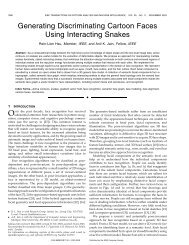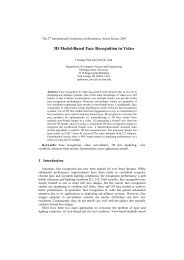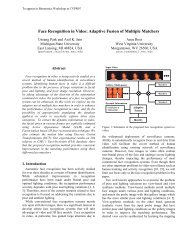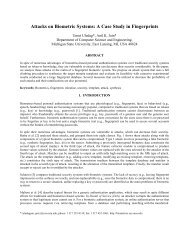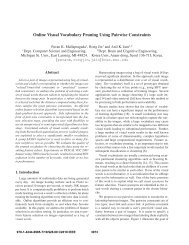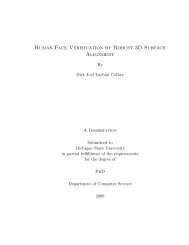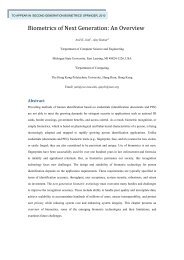Face Detection and Modeling for Recognition - Biometrics Research ...
Face Detection and Modeling for Recognition - Biometrics Research ...
Face Detection and Modeling for Recognition - Biometrics Research ...
You also want an ePaper? Increase the reach of your titles
YUMPU automatically turns print PDFs into web optimized ePapers that Google loves.
matching cost in the algorithm). The algorithm uses our face detection method to<br />
locate faces <strong>and</strong> facial features in all the images, <strong>and</strong> the coarse <strong>and</strong> fine alignment<br />
methods to extract semantic facial features <strong>for</strong> face matching. Finally, it computes a<br />
matching cost <strong>for</strong> each comparison based on selected facial components, the derived<br />
component weights (distinctiveness), <strong>and</strong> matching score (visibility).<br />
Figure 5.15.<br />
A semantic face matching algorithm.<br />
INPUT:<br />
- N j training face images <strong>for</strong> the subject P j , j = 1, . . . , M<br />
- one query face image <strong>for</strong> unknown subject Q<br />
Step 1: Detect faces <strong>for</strong> all the images using the method in [175]<br />
−→ Generate locations of face <strong>and</strong> facial features<br />
Step 2: Form a set of facial components, T , <strong>for</strong> recognition by assigning prior<br />
component weights<br />
Step 3: Coarsely align a generic semantic face graph to each image based on T<br />
−→ Obtain component matching scores <strong>for</strong> each graph in Eq. (5.4)<br />
Step 4: De<strong>for</strong>m a coarsely-aligned face graph<br />
−→ Update component matching scores based on integrals of<br />
component energies<br />
Step 5: Compute semantic facial descriptors SGD <strong>for</strong> each graph<br />
using the 1-D Fourier trans<strong>for</strong>m in Eq. (5.1).<br />
Step 6: Compute semantic component weights <strong>for</strong> each graph in Eqs. (5.19)-(5.21)<br />
Step 7: Integrate all the face graphs of subject P j in Eq. (5.23),<br />
resulting in M template face graphs<br />
Step 8: Compute M matching costs, C(P j , Q k ), between P j <strong>and</strong> Q k in Eq. (5.24),<br />
where k = 1, j = 1, . . . , M<br />
Step 9: Subject P J with the minimum matching cost has the best matched face<br />
to the unknown subject Q k .<br />
OUTPUT:<br />
Q = P J<br />
5.4.3 <strong>Face</strong> Matching<br />
We have constructed a small face database of ten subjects (ten images per subject)<br />
at near frontal views with small amounts of variations in facial expression, face orien-<br />
134



